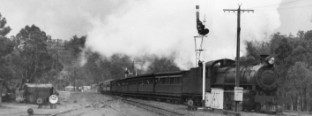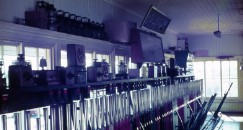Merredin
WAGR - Eastern Goldfields Railway (E. G. R.) | |
1938 WAGR MAP Mileage = 169 | |
Next Down Station: | Next Up Station: |
BOORAAN | NANGEENAN |
Quick Facts |
|
Opened |
Closed |
1916 |
1970 |
Mechanical |
Electrical |
95 Levers |
Electric Track Indicators |
Preserved on Site and open to the Public |
|
Merredin signal box is still located on the W. A. G. R. Eastern Goldfields Railway and was one of this state's larger signal cabins. The photo above, provided by Peter Ipkendanz, shows the view of the front (north wall) of the cabin after closure. Note the missing interlocking room window and two of the ‘T-iron removal hatches’ are also absent. Despite this, and the missing point rodding, (that should be evident between the cabin and the platform), the cabin created an imposing structure above the station buildings. Merredin, with its 95 levers, was also among the state’s largest frames.
When first constructed, the Eastern Goldfields Railway was single track. The method of train working used in 1896 was Staff and Ticket. Whilst it was a very basic system devised to prevent two trains being in the same section of line between two adjacent Staff Stations at the same time, it quite literally had a colourful history! In the early days, the timber staffs (sometimes called ‘staves’ after the parts of a barrel) had a wide variety of shapes and colours, with some even being multi-coloured. In 1896, the section Hines Hill to Merredin used a round shaped, Pink coloured Staff, whilst the section Merredin to Burracoppin used a round shaped, White coloured Staff. Although these two staffs were of the same shape, there was not a great difference between the colours - especially when being handled by the coal-dirty hands of the steam locomotive Drivers or Firemen. And one can only imagine the difficulties of recognising the proper colours of these staffs at night in the meagre light of an engine crew’s oil lamp! Luckily, Train Staffs were also fitted with brass identification plates.
Prior to the provision of the Signal Box, Point Indicators were fitted to the main line points on the 18th April 1898.
The 1901 Appendix to the Working Time Table cites that the predominant system of working along the Eastern Goldfields Railway was Electric Staff working.
The section Nangeenan to Merredin used staffs with round shaped heads, painted Red, whilst the section Merredin to Booraan used staffs with oblong shaped heads, painted Blue in Colour. During 1902, instructions were issued regarding the introduction of "Automatic Electric Staff Columns." Outwardly, the Staff Instruments themselves looked exactly the same as those at attended stations and or signal boxes - except perhaps for the switch on the Back Board. By 1905 it was the provision of this new type of circuit that permitted the removal of a Staff by an employee arriving at an unattended station. This simplified the usage of these instruments and, unfortunately for some, the number of employees required to work them.
The Point Indicators installed at Merredin in 1898 were removed on the 23rd September 1905 when Home and Distant signals were provided. An entry in Weekly Notice 39 of 1905 reported that these “…Levers are fixed on platform close to Booking Office. Facing points are fitted with detectors, and Home signals can only be lowered for main line.” Weekly Notice No. 11 of 1914 reported that "...On Monday, 9th March, 1914, the signalling at Merredin, as per C. E. E. L. Plan No. 12875A, will be brought into use..." also of interest, was the return of Point Indicators "The special attention of Engine-drivers is directed to the point indicators at the Junction points; green is exhibited on the side the road is set for." This intimates that the point indicator was of the square type with two colours showing on each side of the square facing the Driver of an approaching train - these colours would appear to 'swap sides' when the points to which they were connected changed.
Interlocking was installed here in 1916, and although the official construction date of the Merredin Signal Box has yet to be established by this author, this does coincide with the appointment of its first Signalmen.
On the 8th of March 1918 the Signalman at Merredin was assisted in the execution of his duties by the provision of an additional safety system. These were, at the time, referred to as "Insulated Sections" - today they are referred to as Track Circuits and their use forms the cornerstone of railway safety into the present era. Their initial application to Merredin is detailed below:
“E. R., Merredin - Additional Security - Insulated Sections.
No. 1 and 2 Platform Roads at Merredin, between the Up and Down Starting Signals, are insulated. When a train or portion of a train is standing on No. 1 Platform Road, Nos. 9, 10, 11 and 85 signals are electrically locked, and when a train or portion of a train is standing on No. 2 Platform Road, Nos. 2, 4. 6. And 86 Signals are electrically locked. Indicators are provided in the Signal Box to show the condition of the Insulated Roads. When the section is clear, GREEN is exhibited, and the levers are free. When the section is occupied, RED is exhibited, and the levers are locked."
Indicator batteries are provided with “Cut Out” switches, having three positions, viz., “1,” “OUT,” and “2,” the normal position being on either “1” or “2.” The OUT position is used only when the insulated road is occupied for more that five minutes, and shows RED. It is used to economise battery power. If the indicator shows RED when the Signalman considers it ought to show GREEN, the switch should be reversed, and if GREEN is then shown, it indicates the section is CLEAR. If, however, it still shows RED, the signalman, after satisfying himself that the line is not occupied, will act as provided on page 68 of this Appendix.”
Many alterations to the Merredin yard were brought about with the construction of the Standard Gauge railway through the yard in 1966. Diagram of Signalling C. C. E. Plan No.57891, gives a full lever description and also shows the alignment of the Standard Gauge during the initial phase of the construction. In addition to the elevated signal box, parts of the Merredin control area were worked by ground lever frames "B" and "C"- Frame "C" recorded as being taken out of use along with the elevated signal box on 7th of January 1970. Frame "A" was brought into use on the same day and was itself taken out of use on 15th of March 1973.
Today, the Merredin Signal Cabin is an integral and important part of the Merredin Museum and Historical Society’s display called “The Old Station Museum”. The Merredin signal box is open for public inspection and there are numerous signalling exhibits elsewhere at the site, including the now redundant signalling console from West Merredin that had once taken over the lever signal box’s operation. The Merredin signal box is preserved in the very location where it was first built - a rare claim in contemporary Western Australia, and one that is shared with Claremont Signal Cabin, also now fully preserved.
Information researched and interpreted by Chris. J. E. French of SignallingWA
Photographs © by Chris. J. E. French, Peter Ipkendanz, Dr. J. W. F. Scrimgeour and Diagram of Signalling and Photograph © by W. A. G. R.
This page is copyright, and permission must be sought from SignallingWA before this page is used for any purpose other than personal education.
Buy this page or View your SignallingWA ShoppingCart
This page is copyright, and permission must be sought from SignallingWA before this page is used for any purpose other than personal education.
Below: Merredin in the days of Steam - Thanks to Walter Rowe who shared 'Toota' Newton's video on facebook 20/02/2015
MERREDIN Employees | ||
This list may not be complete and does not yet include employees who worked here without being appointed. Where an appointment date is unknown, the Weekly Notice (WN) date advising of the appointment or other official documentation, i.e. Certificate of Competency (CC) will be used. | ||
Name | Appointed | Position |
Gorman, Sydney James Bligh | 13/01/1916 | Signalman, Class 3 |
Hocking, Henry Absolom | 02/03/1917 | Signalman, Class 3 |
Thompson, Harold Francis | 30/11/1920 | Signalman |
Flynn, James | 14/02/1921 | Signalman |
Gunn, F. C. | 18/11/1921 | Signalman, Class 3 |
Green, Charles Arthur | 05/04/1922 | Signalman, Class 3 |
Biddle, Wilfrid R. V. | 15/06/1923 | Signalman, Class 2 |
Stevens, Sidney | 11/07/1923 | Signalman, Class 2 |
Hocking, Henry Absolom | 11/03/1925 | Signalman, Class 2 |
Flynn, James | 30/11/1925 | Signalman, Class 2 |
Hall, Cyril Manning | 19/10/1927 - WN 42/1927 | Signalman, Class 2 |
O'Brien, Stephen | 28/01/1928 | Signalman, Class 3 |
Robertson, E. | WN 23 /1928 | Signalman, Class 2 |
Pulford, Joseph Robert | 19/11/1928 - WN 38/1928 | Signalman, Class 2 |
Christie, Robert Alexander | 11/05/1932 - WN 45/1932 | Signalman, Class 2 |
Hagarty, Stuart | 09/05/1935 - WN 15/1935 | Signalman, Class 2 |
Oldfield, Douglas Hyde | 19/07/1935 - WN 20/1935 | Signalman, Class 2 |
Jamieson, William, T. | 05/08/1936 - WN 28/1936 | Signalman, Class 2 |
Winzer, Kevin Philip | 10/12/1937 | Signalman, Class 2 |
Thornber, Cecil, Norman | 26/05/1938 - WN 26/1938 | Signalman, Class 2 |
Searle, William Roy | 22/07/1940 - WN 29/1940 | Signalman, Class 2 |
Logan, Alexander Allen | 12/08/1940 - WN 29/1940 | Signalman, Class 2 |
McKinnon, Gordon Andrew | 07/05/1941 - WN 16/1941 | Signalman, Class 2 |
Rutherford, William Norman | 02/06/1941 | Signalman |
Field, John, C. | 10/05/1943 - WN11/1943 | Signalman |
Mills, Harry | 25/05/1943 - WN 19/1943 | Signalman, Class 2 |
Riseley, Denys | 29/06/1945 | Signalman |
Le Cheminant, Norman G. | WN 24/1946 | Signalman, Class 2 |
Porteus, William Brydon Frederick | 27/06/1946 | Signalman, Class 2 |
Mays, Ronald Lloyd | WN 28/1947 | Signalman, Class 2 |
Bidwell, Edward William | WN 28/1947 | Signalman, Class 2 |
Bidwell, Edward William | 30/09/1947 | Signalman |
Chisolm, R. A. | WN 46/1947 | Signalman |
Mays, Ronald Lloyd | 04/11/1947 | Signalman |
Parker, D. K. | WN 02/1948 | Signalman |
Wilkins, S. L. | WN 17/1948 | Signalman, Class 2 |
Hunt, Victor W. | WN 17/1948 | Signalman, Class 2 |
Palmer, H. T. B. | WN 17/1948 | Signalman, Class 2 |
Hoskyns-Abrahall, C. L. | WN 21/1948 | Signalman, Class 2 |
Gardiner, William | WN 26/1950 | Signalman, Class 2 |
Gardiner, William | 23/10/1950 | Signalman, Class 2 |
Dickhart, Gordon B. | WN 15/1951 | Signalman, Class 2 |
Howman, William Gordon | 19/07/1951 | Signalman, Class 2 |
Beard, Harold Alfred | 21/06/1956 | Signalman, Class 2 |
Smith, Henry, Thomas | 07/10/1957 | Signalman, Class 2 |
Street, Leonard Stanley | 13/07/1959 - WN 30/1959 | Signalman, Class 2 |
Brazier, Harold Arthur | 22/06/1961 | Signalman, Class 2 |
Polinski, T. | WN 47/1961 | Signalman, Class 2 |
O'Dea, Clifford Bertram | 24/07/1963 | Signalman, Class 2 |
Brazier, Harold Arthur | 24/12/1964 | Signalman, Class 2 |
Galant, Leslie Anthony | 23/01/1968 | Area Signalman |
Muddle, John | 25/06/1968 | Signalman, Class 2 |
Is a name missing? Please submit any corrections / additions with suitable evidence using the e-mail form above. | ||


